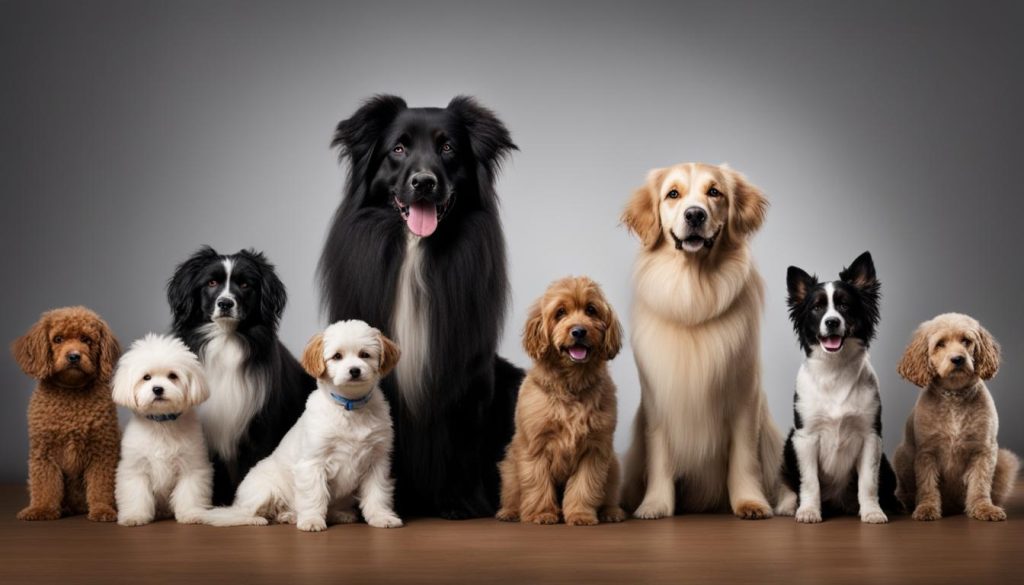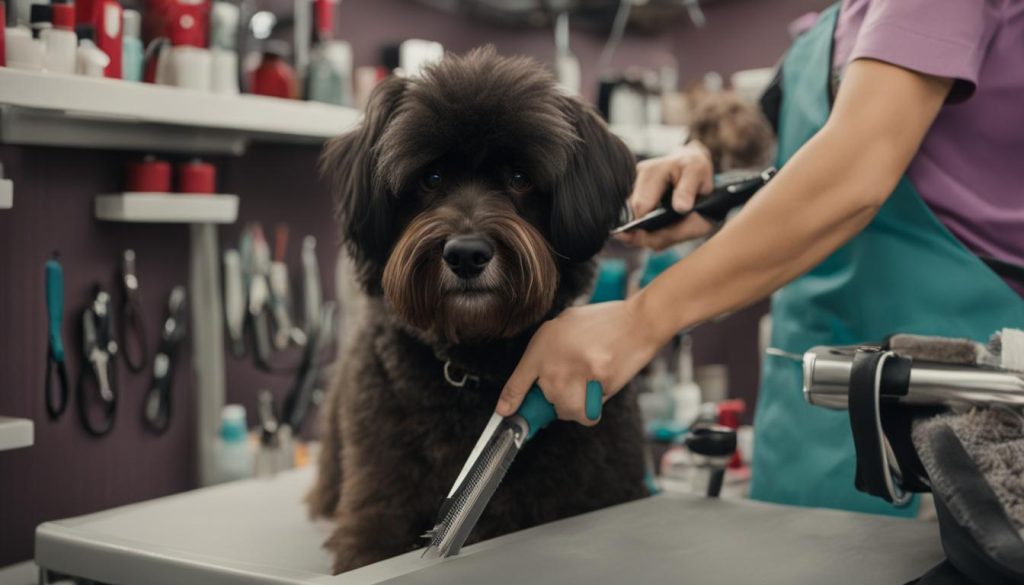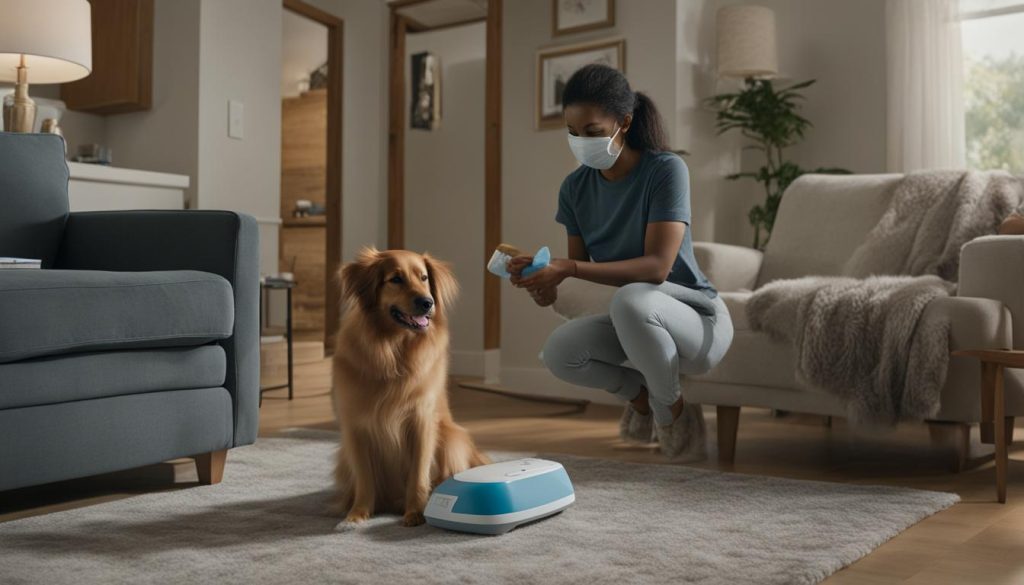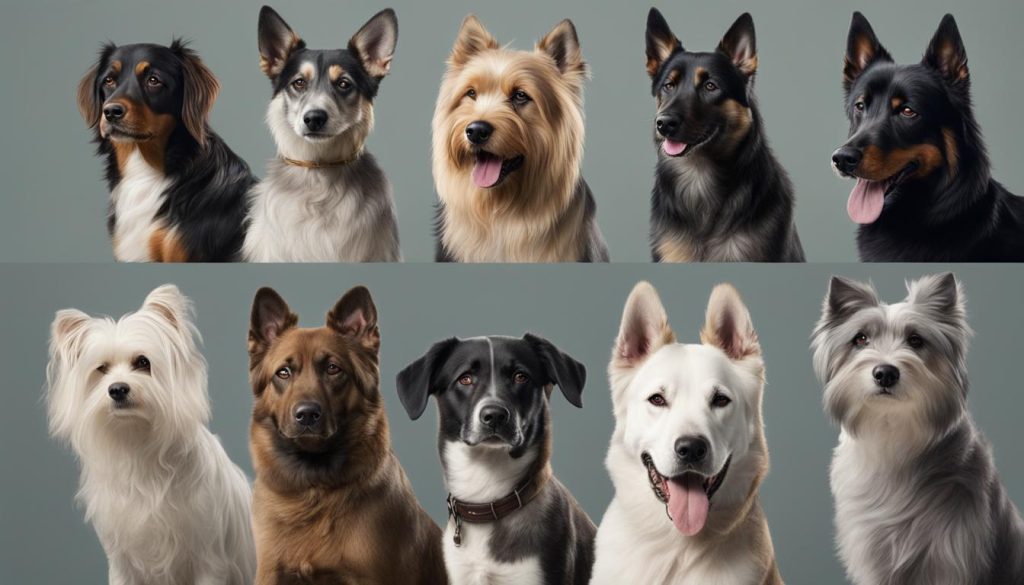According to various sources, while no dog is 100% hypoallergenic, there are certain dog breeds that are better suited for allergy sufferers. These hypoallergenic dogs have non-shedding coats and produce less dander, which is the main cause of pet allergies in people. By choosing the right breed and taking certain precautions, people with allergies can still enjoy the companionship of a dog. In this article, I will explore the best dogs for people with allergies and provide detailed information about each breed.
Key Takeaways:
- Hypoallergenic dog breeds are better suited for people with allergies.
- These breeds have non-shedding coats and produce minimal dander.
- Choosing the right breed and implementing measures can allow allergy sufferers to enjoy the company of a dog.
- Research and education are essential in finding the best hypoallergenic dog breed.
- Proper care, grooming, and allergen control measures are necessary for allergy-safe dog ownership.
Understanding Hypoallergenic Dogs and Allergies
People who suffer from allergies to cats and dogs often wonder if there are any dog breeds that are hypoallergenic. While no dog is completely hypoallergenic, there are breeds that produce fewer allergens and are better suited for allergy sufferers. These hypoallergenic breeds have coats that don’t shed as much, which reduces the amount of dander, saliva, and urine allergens in the environment. By choosing a hypoallergenic dog breed and implementing certain measures to reduce allergens in the home, people with allergies can enjoy the company of a dog without experiencing severe allergic reactions.
I recommend that you understand that the term “hypoallergenic” does not mean that these breeds are completely allergen-free. All dogs produce allergens to some extent, but hypoallergenic breeds produce fewer allergens and are considered more allergy-friendly. The level of allergens can vary among individuals, so I would advise that you spend time with a dog of the hypoallergenic breed before bringing one home to ensure compatibility.
When considering hypoallergenic dogs, please consider the specific needs and sensitivities of the individual with allergies. While these breeds may produce fewer allergens, they still require regular grooming and maintenance to keep their coats healthy and reduce the risk of allergic reactions. Additionally, allergy sufferers should take precautions to minimize contact with allergens, such as washing hands after petting or playing with the dog and keeping the dog out of the bedroom.

In summary, while no dog breed is completely allergy-free, hypoallergenic dog breeds produce fewer allergens and are better suited for people with allergies. By choosing a hypoallergenic breed, implementing proper grooming and maintenance, and taking necessary precautions, individuals with allergies can still enjoy the companionship of a dog without experiencing severe allergic reactions.
Best Hypoallergenic Dog Breeds
When it comes to finding a dog that is suitable for people with allergies, hypoallergenic breeds are the best option. These breeds have non-shedding coats and produce minimal dander, making them less likely to trigger allergic reactions. Here are some of the best hypoallergenic dog breeds:
| Breed | Description |
|---|---|
| Afghan Hound | Known for their elegant appearance and silky coat, Afghan Hounds are hypoallergenic and make great companions. |
| American Hairless Terrier | As the name suggests, this breed has no hair, which significantly reduces the amount of allergens they produce. |
| Bichon Frise | With their fluffy white coat, Bichon Frises are a popular choice for allergy sufferers. They are also known for their friendly and affectionate nature. |
| Poodle | Poodles come in three sizes: standard, miniature, and toy. They have curly hair that doesn’t shed much, making them a great option for people with allergies. |
These are just a few examples of hypoallergenic dog breeds. Each breed has its own unique characteristics and care requirements, so research and choose a breed that matches your lifestyle and preferences. Keep in mind that individual sensitivities to allergens can vary, so it’s advisable to spend time with the breed before making a decision.
By selecting a hypoallergenic dog breed, you can enjoy the companionship of a furry friend without the worry of severe allergic reactions. Try to groom your dog regularly, keep their living environment clean, and take necessary precautions to minimize allergens in your home. With proper care and attention, owning a hypoallergenic dog can be a rewarding experience for allergy sufferers.
Characteristics of Hypoallergenic Dog Breeds
Hypoallergenic dog breeds have specific characteristics that make them more suitable for people with allergies. These breeds typically have non-shedding coats, which means they don’t release as much dander into the environment. This reduced dander production helps minimize the risk of allergic reactions.
Additionally, hypoallergenic dogs often have a different type of coat, such as curly or wiry, which helps trap allergens and prevent them from becoming airborne. This is beneficial for allergy sufferers as it reduces the likelihood of coming into contact with allergens that can trigger symptoms.
while hypoallergenic dog breeds can be a good option for people with allergies, individual sensitivities to allergens can still vary. Therefore, it’s recommended to spend time with a dog of the hypoallergenic breed before bringing one home to ensure compatibility and minimize the risk of allergic reactions.
| Hypoallergenic Dog Breed | Coat Type | Characteristics |
|---|---|---|
| Poodle | Curly | Non-shedding, minimal dander |
| Bichon Frise | Curly | Non-shedding, low dander |
| Maltese | Silky | Non-shedding, minimal dander |
| Shih Tzu | Long, flowing | Non-shedding, low dander |
These are just a few examples of hypoallergenic dog breeds. Each breed has its own unique characteristics and care requirements, so consider factors such as size, energy level, and compatibility with your lifestyle and allergies when choosing a hypoallergenic dog.
In summary, hypoallergenic dog breeds have specific traits that make them more suitable for people with allergies. Their non-shedding coats and reduced dander production help minimize allergens in the environment and reduce the risk of allergic reactions. However, individual sensitivities can still vary, so I would advise that you spend time with a hypoallergenic dog before making a commitment. By considering these characteristics and finding the right breed, people with allergies can enjoy the companionship of a dog while managing their allergies effectively.
Grooming and Maintenance for Hypoallergenic Dogs
Hypoallergenic dogs may be known for shedding less and producing fewer allergens, but they still require regular grooming and maintenance to keep them healthy and comfortable. Grooming routines for hypoallergenic dogs vary depending on the breed, but they typically involve regular brushing, bathing, and trimming. These tasks help to remove loose hair, prevent matting, and keep the dog’s coat in good condition. I recommend that you use the right grooming tools and techniques specific to the breed to avoid causing any discomfort or skin irritations. Regular grooming sessions also provide an opportunity to check for any skin issues, such as dryness or allergies, and address them promptly.
Keeping the dog’s living environment clean is also crucial for reducing allergens. Regular washing of the dog’s bedding and vacuuming of the house helps to remove allergens like dander, dust, and pollen. Using allergy-friendly cleaning products and air purifiers further minimizes the presence of allergens in the living space. I recommend that you create a clean and allergen-free environment for both the dog and the allergy sufferer.
Table: Hypoallergenic Dog Grooming Needs
| Breed | Grooming Needs |
|---|---|
| Poodle | Regular brushing, professional grooming every 4-6 weeks |
| Bichon Frise | Regular brushing, professional grooming every 6-8 weeks |
| Maltese | Daily brushing, monthly bathing |
| Shih Tzu | Daily brushing, regular bathing, frequent face cleaning |
| Yorkshire Terrier | Daily brushing, regular bathing |
Regular grooming and maintenance not only help to keep hypoallergenic dogs looking their best, but it also contributes to their overall health and well-being. It’s a responsible and essential part of caring for these special dogs and ensuring a comfortable living environment for allergy sufferers.

Allergy Precautions for Dog Owners
As a dog owner with allergies, there are several precautions you can take to minimize allergic reactions and enjoy the company of your hypoallergenic dog. First and foremost, I would advise that you wash your hands thoroughly after petting or playing with your dog to remove any allergens that may be on your skin. This simple practice can significantly reduce the risk of an allergic reaction.
Avoiding contact with your dog’s saliva and urine is also crucial. These substances can contain allergens that can trigger allergies in sensitive individuals. By being mindful of your interactions and practicing good hygiene, you can further minimize allergic reactions.
Keeping your dog out of the bedroom is another effective precaution. Your place of sleep should be a sanctuary free from allergens, and allowing your dog in the bedroom can introduce dander and other allergens into the space. Create designated areas for your dog within your home and regularly clean these areas to reduce allergen buildup.
| Allergy Precautions for Dog Owners |
|---|
| Wash hands after petting or playing with the dog |
| Avoid contact with the dog’s saliva and urine |
| Keep the dog out of the bedroom |
| Designate specific areas for the dog and regularly clean them |
Consulting with your healthcare provider is also recommended to discuss appropriate allergy medications and treatments that can help manage your symptoms. They can provide personalized advice and guidance based on your specific allergies and medical history.
By taking these allergy precautions, you can create a safe and comfortable environment for both you and your hypoallergenic dog. With proper care and management, you can enjoy the companionship and love of a dog without experiencing severe allergic reactions.

Personal Stories of Allergy Sufferers with Hypoallergenic Dogs
Many allergy sufferers have shared their heartwarming stories about owning hypoallergenic dogs and how these furry companions have significantly improved their lives. These personal narratives highlight the positive impact that hypoallergenic dog breeds can have on individuals with allergies, showing that it is possible to find a compatible four-legged friend despite the challenges posed by allergies. Let’s take a closer look at some of these inspiring stories.
One such story is from Sarah, who had always longed for a dog but struggled with severe allergies. After researching hypoallergenic dog breeds, she decided to welcome a Bichon Frise into her home. To her surprise, she experienced no allergic reactions and could finally enjoy the companionship she had always desired. Sarah now proudly shares her story to encourage others with allergies to consider hypoallergenic dog breeds, emphasizing that finding the right match can be life-changing.
“I never thought I would be able to have a dog due to my allergies, but my Bichon Frise has changed everything. She is hypoallergenic and doesn’t shed, which means I can cuddle and play with her without any allergic reactions. Having her by my side has brought so much joy and comfort to my life. If you have allergies like I do, don’t give up on your dream of having a dog. There are hypoallergenic breeds out there that can change your life just like they changed mine.” – Sarah
Another touching story is from Alex, who was hesitant to bring a dog into their home because of their partner’s allergies. After extensive research and consultations with veterinarians, they adopted a Portuguese Water Dog. This hypoallergenic breed’s non-shedding coat and low dander production proved to be the perfect fit for their family. Alex now shares their story to encourage other allergy sufferers to explore hypoallergenic dog options and experience the love and companionship these dogs can provide.
These personal stories of allergy sufferers finding compatibility and joy with hypoallergenic dogs serve as a testament to the power of these breed choices. They demonstrate that hypoallergenic dogs can positively impact the lives of allergy sufferers, providing companionship, emotional support, and unconditional love without triggering severe allergic reactions. If you have allergies and have been longing for a canine companion, consider the stories of those who have found their perfect match and let them inspire you to explore hypoallergenic dog breeds for yourself.

Table: Stories of Allergy Sufferers with Hypoallergenic Dogs
| Name | Breed | Experience |
|---|---|---|
| Sarah | Bichon Frise | Life-changing companionship without allergic reactions |
| Alex | Portuguese Water Dog | Overcoming partner’s allergies through a hypoallergenic breed |
Dog Allergies and Children
Children with allergies can still enjoy the joys of owning a dog with the right hypoallergenic breed. It’s important for parents to consider the specific needs of their child and choose a breed that is well-suited for children and is hypoallergenic. Hypoallergenic breeds can provide children with the love and companionship of a dog without triggering severe allergic reactions. However, please supervise interactions between the child and the dog, practice proper hygiene, and consult with healthcare professionals to ensure the child’s wellbeing and allergy management.
Introducing a hypoallergenic dog into a household with a child who has allergies requires careful consideration. These breeds have coats that produce minimal dander and saliva, reducing the risk of allergic reactions. However, individual sensitivities can vary, so it’s recommended to spend time with the hypoallergenic breed before bringing one home. This allows parents to gauge their child’s reaction and ensure compatibility.
Supervision is key when children and dogs interact, especially if the child has allergies. Parents should teach their children how to properly interact with the dog, including gentle petting and avoiding contact with the dog’s saliva or urine. Regular hand-washing after playing with the dog is also essential to minimize potential allergens. Consulting with healthcare professionals can provide additional guidance on allergy management and appropriate measures to ensure the child’s safety and wellbeing.

Adoption and Rescue Options for Allergy-Friendly Dogs
For individuals with allergies who are interested in owning a dog, adoption and rescue options are available for hypoallergenic breeds. Many rescue organizations and shelters have hypoallergenic dogs available for adoption, providing an opportunity to give a loving home to a dog in need while also addressing allergy concerns. You should also research and communicate with rescue organizations to ensure compatibility between the dog’s hypoallergenic qualities and the individual’s allergies. Adoption and rescue options can be a rewarding way to find a compatible hypoallergenic dog and contribute to the welfare of animals.
Benefits of Adoption and Rescue
Adopting a hypoallergenic dog from a rescue organization has several benefits. Firstly, it allows individuals to provide a second chance to a dog in need. Many hypoallergenic breeds end up in shelters and rescues due to various reasons, such as their previous owners’ inability to care for them or a change in circumstances. By adopting a rescue dog, individuals can make a positive impact on the dog’s life and give them a loving forever home.
Furthermore, adopting a hypoallergenic dog from a rescue organization often comes at a lower cost compared to purchasing a dog from a breeder. Adoption fees usually cover the dog’s vaccinations, spaying or neutering, and sometimes even microchipping. This can result in significant savings compared to the expenses associated with buying a dog from a breeder.
Things to Consider
When considering adoption or rescue, please evaluate the compatibility between the hypoallergenic dog and the individual’s allergies. While hypoallergenic breeds generally produce fewer allergens, individual sensitivities can still vary. It’s recommended to spend time with the dog before making a decision to assess any potential allergic reactions. Some rescue organizations may offer a trial period or a foster-to-adopt option, allowing individuals to ensure compatibility before finalizing the adoption.
Additionally, research and communicate with the rescue organization about the dog’s health history, temperament, and any specific care requirements. Gathering as much information as possible will help individuals make an informed decision and ensure that the hypoallergenic dog is a good fit for their lifestyle and home environment.
| Adoption and Rescue Checklist | |
|---|---|
| Research local rescue organizations and shelters |  |
| Check for hypoallergenic dog availability | |
| Communicate with the rescue organization about individual allergies | |
| Spend time with the dog to assess compatibility | |
| Consider a trial period or foster-to-adopt option | |
| Ask about the dog’s health history and care requirements | |
| Be prepared to provide a loving forever home |
Tips for Finding the Best Hypoallergenic Dog for You
When it comes to finding the best hypoallergenic dog for you, there are several factors to consider. By taking the time to do your research and make an informed decision, you can find a furry companion that will bring you joy without triggering severe allergic reactions. Here are some tips to help you in your search:
- Understand your specific allergies: I recommend that you know exactly what you’re allergic to and what triggers your symptoms. This will help you narrow down the hypoallergenic dog breeds that are most suitable for you.
- Consider your lifestyle: Think about your activity level, living situation, and the amount of time you can dedicate to exercise, grooming, and training. Different hypoallergenic breeds have varying energy levels and care requirements, so choose one that matches your lifestyle.
- Research hypoallergenic dog breeds: Learn about the characteristics, temperament, and grooming needs of different hypoallergenic breeds. Consider factors such as coat type, size, and compatibility with children or other pets.
- Visit breeders and meet the dogs: Spend time with the hypoallergenic dog breeds you’re considering before making a decision. This will allow you to assess any potential allergic reactions and determine if the breed is the right fit for you.
- Consult with professionals: Seek advice from breeders, veterinarians, and allergy specialists who can provide valuable insights and guidance. They can help you understand the specific needs of hypoallergenic breeds and offer recommendations based on your allergies.
Finding the best hypoallergenic dog involves a combination of personal preference, allergy management, and ensuring the dog’s welfare. By following these tips and being patient in your search, you can find the perfect hypoallergenic companion to bring into your life.
Table: Characteristics of Popular Hypoallergenic Dog Breeds
| Breed | Size | Coat Type | Energy Level | Compatibility with Children |
|---|---|---|---|---|
| Afghan Hound | Large | Long, silky | High | Yes |
| Bichon Frise | Small | Curly | Moderate | Yes |
| Poodle | Various sizes | Curly | High | Yes |
| Maltese | Small | Silky | Moderate | Yes |
| Portuguese Water Dog | Medium to large | Wavy | High | Yes |
“Choosing the right hypoallergenic dog is a personal decision that requires careful consideration. By doing your homework, visiting breeders, and consulting with professionals, you can find the perfect hypoallergenic companion that will bring you years of joy and love.”

Final Thoughts
When it comes to finding the best dogs for people with allergies, hypoallergenic breeds are the way to go. Although no dog is completely hypoallergenic, these breeds have non-shedding coats and produce minimal allergens, making them more suitable for allergy sufferers. By choosing a hypoallergenic dog and implementing proper care and allergen control measures, individuals can enjoy the companionship of a dog without experiencing severe allergic reactions.
For those interested in owning a hypoallergenic dog, adoption and rescue options are available. Many rescue organizations and shelters have hypoallergenic dogs in need of loving homes. I recommend that you research and communicate with these organizations to ensure the compatibility between the dog’s hypoallergenic qualities and your allergies.
When selecting a hypoallergenic dog, please consider factors such as size, energy level, temperament, grooming requirements, and compatibility with your lifestyle and allergies. Spending time with the dog before making a decision can help assess any potential allergic reactions. Consulting with breeders, veterinarians, and allergy specialists can provide valuable guidance in finding the best hypoallergenic dog for you.
To put it simply, choosing a hypoallergenic dog involves a combination of education, preparation, and consideration of individual sensitivities. With the right breed and proper care, people with allergies can have a furry companion that brings joy and happiness to their lives.
FAQ
Are there any dog breeds that are hypoallergenic?
While no dog is completely hypoallergenic, there are breeds that produce fewer allergens and are better suited for allergy sufferers.
What makes a dog breed hypoallergenic?
Hypoallergenic dog breeds typically have non-shedding coats, minimal saliva and urine allergens, and a different type of coat that traps allergens.
What are some hypoallergenic dog breeds?
Some hypoallergenic dog breeds include the Afghan Hound, Bichon Frise, Poodle, and Portuguese Water Dog, among others.
How do I care for a hypoallergenic dog’s coat?
Regular grooming, including brushing, bathing, and trimming, is essential to keep a hypoallergenic dog’s coat healthy and allergen-free.
What precautions should allergy sufferers take with hypoallergenic dogs?
Allergy sufferers should wash their hands after contact, avoid contact with the dog’s saliva and urine, and keep the dog out of the bedroom.
Can children with allergies own hypoallergenic dogs?
Yes, with proper supervision, hygiene, and consultation with healthcare professionals, children with allergies can still enjoy the company of hypoallergenic dogs.
Are there adoption and rescue options for hypoallergenic dogs?
Yes, many rescue organizations and shelters have hypoallergenic dogs available for adoption, offering a chance to give a loving home to a dog in need.
How do I find the best hypoallergenic dog for me?
Consider factors such as size, energy level, temperament, grooming requirements, and compatibility with your lifestyle and allergies. Spend time with the dog and seek advice from experts.






